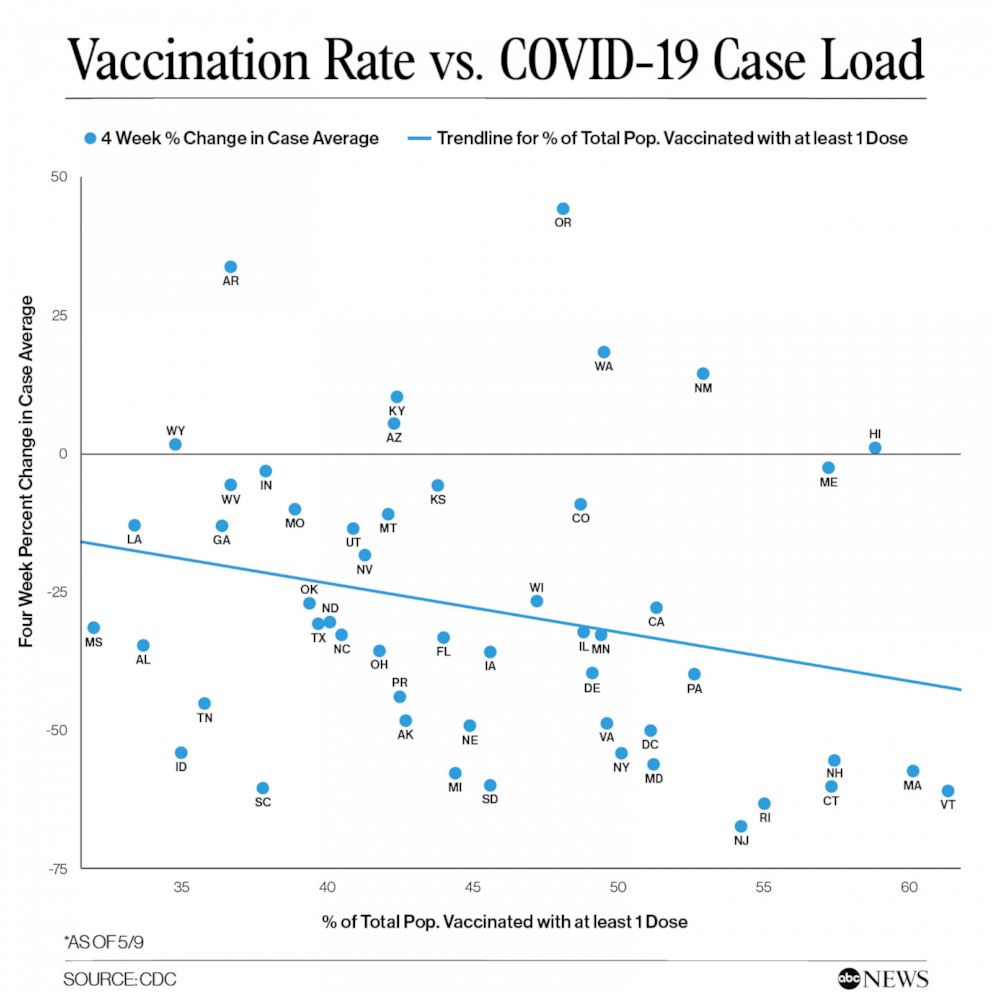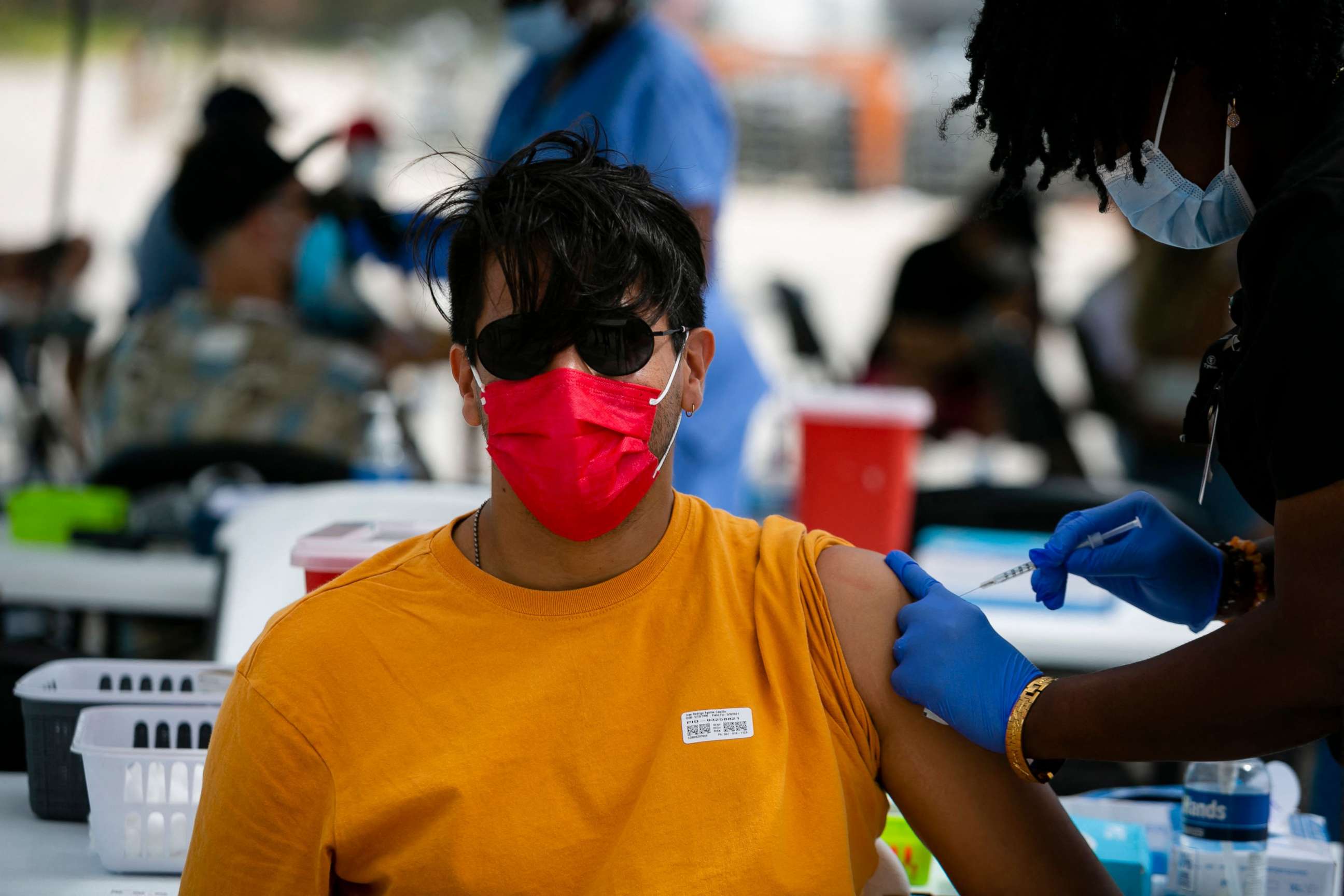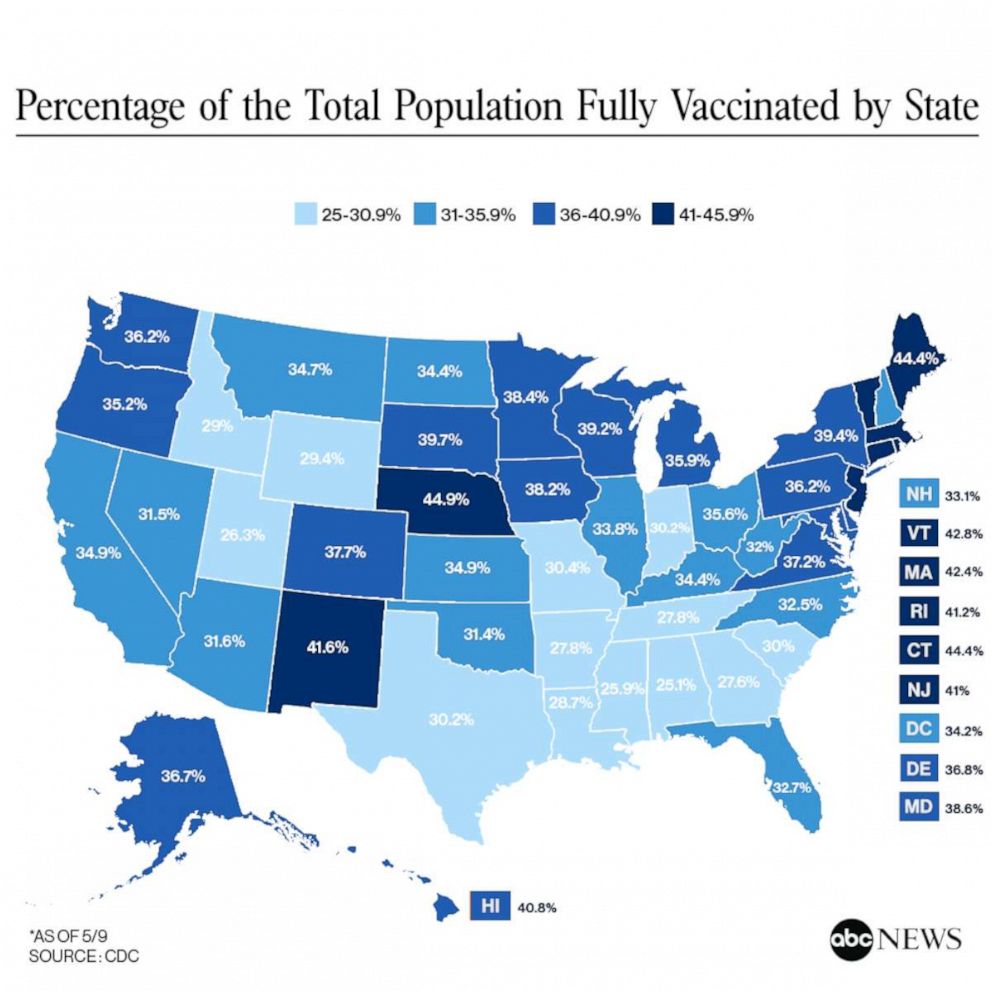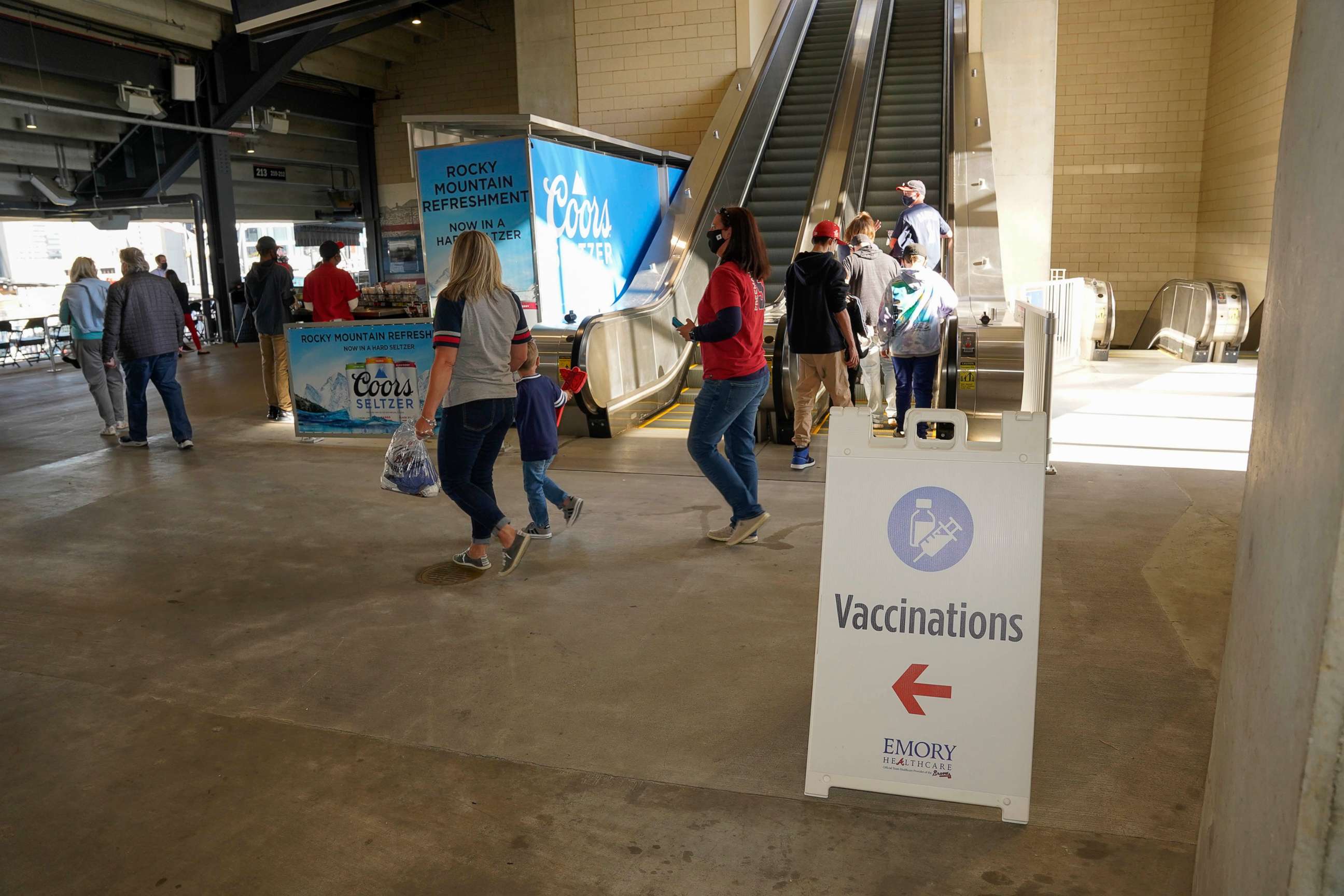COVID-19 vaccinations finally starting to stem pandemic's tide in US: Analysis
ABC News analyzed coronavirus case and vaccination data from all 50 states.
For months, officials and health experts have been urging Americans to get vaccinated against COVID-19, to thwart severe illness, and support the country’s continued fight against the ubiquitous virus that has killed over 582,000 people across the U.S.
Since the first coronavirus vaccinations were authorized for emergency use in December 2020, nearly 154 million Americans have been administered with at least one dose. And although the U.S. has experienced plateauing, and even increasing cases rates at times, the number of new infections has dropped significantly since January, and precipitously in recent weeks.
So how much of an effect are the vaccines having and what accounts for rising case loads and hospitalizations in some places?
A recent ABC News analysis of data from the CDC of all 50 states, Washington, D.C., and Puerto Rico found that there does indeed appear to be a correlation between the rate of vaccination in a given state and the decline in the number of new COVID-19 infections.

With the country experiencing fluctuating case trends in the late winter and early spring, this correlation had not been evident until states began expanding vaccination access to larger swaths of the population late last month.
Most states have experienced a decline in daily cases over the past four weeks, including some where the drop has been dramatic.
Experts say the drops can be in part attributed to the widespread rollout of vaccines, but some say that other factors may be at play too -- at least in tandem, including restrictions and other ongoing mitigation measures, which have been relaxed in some places.
Despite similar levels of vaccine uptake, other states have struggled with plateauing or even increasing cases, which may be the result of pockets of unvaccinated residents or the effects of relaxed mitigation measures.
“One in every three Americans is fully vaccinated, which is contributing to our improving trends. The higher we can push vaccine coverage, the better we’ll be able to maintain control of the virus,” Caitlin M. Rivers, an American epidemiologist and Senior Scholar at the Johns Hopkins Center told ABC News.
However, as states move to reopen, there are growing concerns among health officials that some of the country’s progress could be stymied as vaccination rates wane, virus variants spread, and pockets of the country potentially see upticks in cases and hospitalizations.
States' vaccination success
In analyzing vaccination rollouts, ABC News compared the percentage of total residents with at least one dose of vaccine with the percent change in a state’s daily case average over the span of four weeks, and found that the states with the steepest drops in daily cases were among those with the highest vaccination rates.
Fourteen states already have at least 50% of their population having received at least one COVID-19 vaccine dose. Although one dose of a two-dose vaccine series does afford some protection, it does not offer the full protection received after the second dose. An individual is considered to be fully protected two weeks after administration of the second dose.
With over 44% of its total population fully vaccinated, Connecticut has seen its case rate plummet since it expanded vaccinations to anyone over the age of 16 on April 1 -- 60% in the last four weeks alone.
Between early March and April, Massachusetts experienced a small spring surge. However, after the state opened up vaccinations to residents 55 and older, and then to all adult residents two weeks later, the state’s numbers subsequently began to drop. Since April 10, the state’s daily case average has dropped by over 57%.

Vermont, which currently leads the country in vaccinations administered per 100,000 residents, has seen the largest percent change in its daily case average over the last four weeks, with a nearly 61% decline.
"We can suppress the virus with better vaccine coverage. Disease transmission is local. We want communities to understand the low vaccination rates means higher risk for you and your neighbors,” Rebecca Weintraub, faculty director of the Global Health Delivery Project at Harvard University, told ABC News.
Even states with the lowest vaccination rates, such as Alabama, Mississippi, and Louisiana, have shown improvements in the number of new COVID-19 cases. Only a quarter of Mississippi residents are currently vaccinated, but cases are still down by over 30% from a month ago.
However, experts warn that small surges could appear in states with low vaccination rates next fall. Although the role of vaccines in influencing the decline in community transmission is significant, other potential factors also come into play.
“I think the falling cases are in part due to increasing vaccinations, but not exclusively,” Dr. Angela Rasmussen, a virologist at the Georgetown Center for Global Health Science and Security, told ABC News. “Other factors will be community-dependent, and will depend on both policies and restrictions in place to reduce transmission, as well as the behavior of people within those communities.”
Pockets of local concern
Although state case and vaccination trends can provide a general understanding of how a state is doing, it may mask local variations, with pockets of low vaccine uptake leading to increased coronavirus cases, despite a state’s overall high volume of inoculations.
Testing for the virus has also declined significantly in recent months, leaving the possibility that states are missing potential infections. The U.S. is currently averaging just over 1 million tests a day -- down by the nearly 2 million tests a day the country was conducting in January.
Slowing vaccination rates “will really depend again on immunization at the community level,” explained Rasmussen.
For example, with 44% of its population fully vaccinated, Maine currently leads the country along with Connecticut for the highest percentage of its total population that is fully vaccinated. However, with 42% of its population still unvaccinated, Maine has recently seen a surge in hospitalizations, particularly among younger, unvaccinated populations.
Although cases are still lower than they were a month ago, Maine is still averaging about 300 cases a day. On Saturday, 47% of the state’s new cases were among residents under the age of 30.

In Oregon, daily cases have increased by 44% over the last month, despite the fact that 48% of residents are now vaccinated with at least one coronavirus vaccine dose. And in Hawaii, nearly 59% of the state's total population has received at least one dose, however, in the last two weeks, cases have increased by approximately 12%.
Rising cases in these states may be due to a number of factors, including the effect of more contagious virus variants on largely younger, unvaccinated populations.
GOTV: Get out the vaccine
In order to keep case rates falling, experts say it will be critical for vaccinations efforts to reach unprotected individuals.
“In the states with a lower vaccination rate there is a greater risk that variants continue to emerge, evolve,” said Weintraub. Therefore, it will be crucial to accelerate access to the vaccines. “Our work ahead, similar to getting out the vote -- we need local campaigns to answer questions and help sign up the vaccinated.”
Many states are now refocusing their efforts to bring vaccines to their residents, using mobile vaccination vans to reach more rural or other traditionally underserved communities, door-to-door canvassing, and community education to address hesitancy.

"The most successful states have used a wide variety of techniques… This is not something that will be solved through a single strategy. It takes targeted outreach to communities,” Dr. Megan Ranney, an emergency room physician and professor at Brown University.
The White House continues its push to get 70% of all U.S. adults inoculated with at least one shot by July 4. To date, nearly 59% of U.S. adults have received their first dose.
On Tuesday, President Joe Biden announced that anyone in need of a ride to get their COVID-19 vaccine would be able to get a free trip through ride-sharing companies Lyft and Uber for the next two months.
“We have reached the people who really wanted the vaccines already. Now it is a matter of the ground game to reach the people who would be interested, but won’t go out of their way… every vaccine in an arm makes a difference," Ranney concluded.






